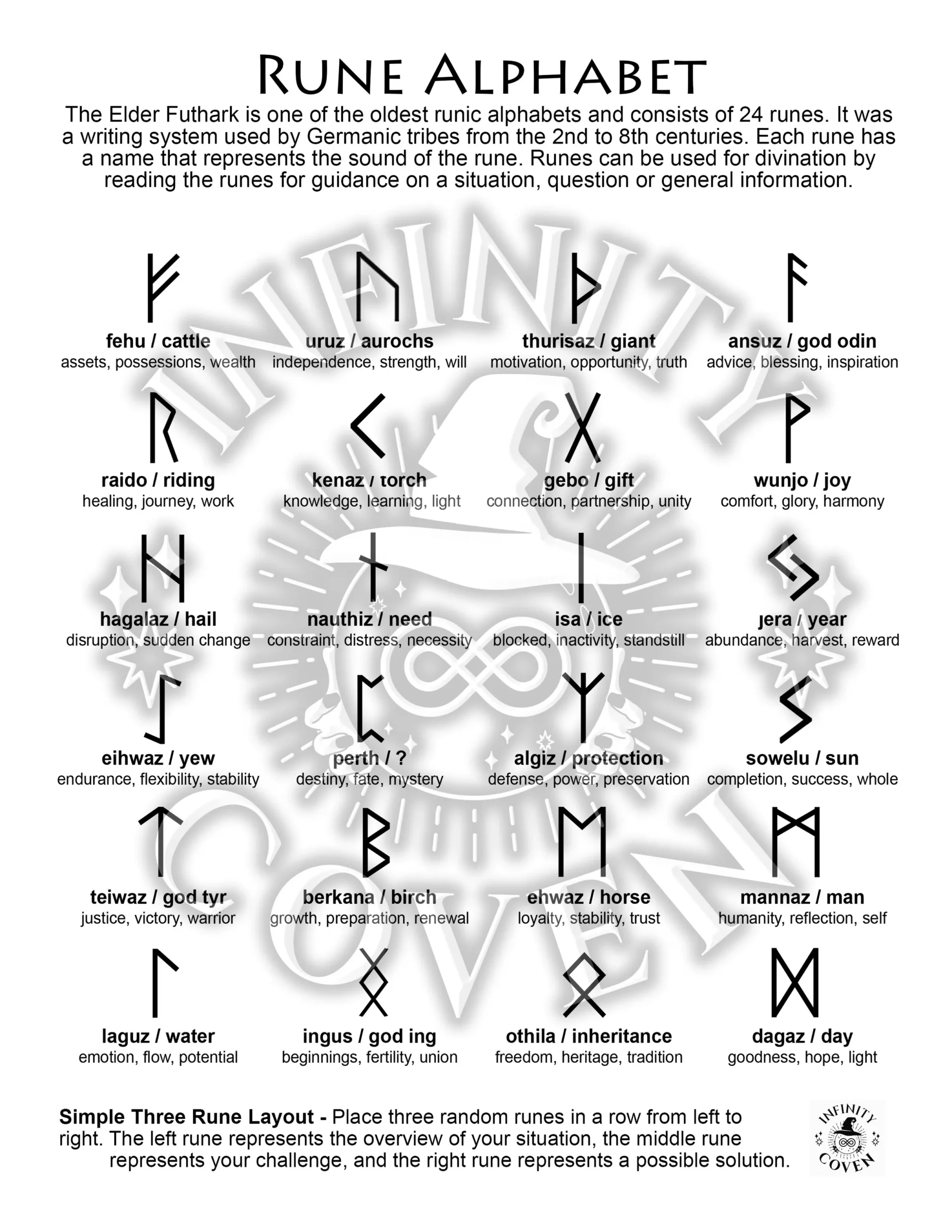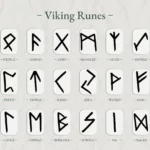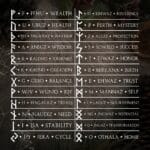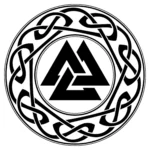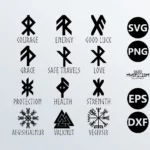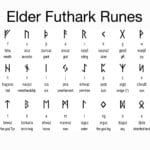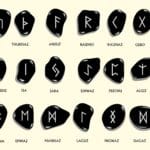Get ready for a wild ride into the mysterious world of the Futhark runes, the ancient Nordic symbols that were like the power tools of the people back in the day. We’ll dig into their roots in Nordic myths, how they were used for telling the future, magic, and even just everyday stuff. So, buckle up and let’s dive into the secrets of these ancient symbols and the awesome civilizations that used them like it was nobody’s business.
Futhark Runes: Unearthing the Enigmas of an Ancient Alphabet
In the tapestry of history, the futhark runes stand out as enigmatic characters that whispered secrets to our ancestors from centuries past. These ancient symbols, born during the bustling Migration Period, carry the essence of Old Italic scripts and were etched upon artifacts found primarily in the Nordic lands, particularly Denmark.
Their composition is both meticulous and meaningful, with 24 runes arranged into three groups known as ættir. Each rune is a vessel for a specific concept or sound, embodying the principle of acrophony. For instance, Fehu represents the abundance of cattle, while Tiwaz embodies the formidable god Tyr.
The futhark runes have found a home in the digital realm, meticulously encoded within Unicode’s unified Runic range. This ensures their preservation and accessibility, allowing them to grace our screens with their enigmatic presence.
Throughout the ages, the futhark runes have served as a conduit for both mundane and mystical endeavors. They adorned weapons and amulets, whispering tales of battles and casting protective spells. Runestones, towering monuments of stone, bear their cryptic inscriptions, offering tantalizing glimpses into the beliefs and practices of ancient peoples.
Beyond their linguistic significance, the futhark runes are a testament to the richness of Norse culture. They hold clues to the worldview, mythology, and spirituality of these forgotten societies, inviting us to decipher their enigmatic messages and unravel the threads of their ancient wisdom.
Would you like to learn more about the ancient symbols used by the Vikings? Check out our page on viking rune symbols for insights into their history and meanings. If you’re interested in the deeper significance of these runes, delve into our article on rune stone meanings, where we explore their esoteric interpretations. To gain a comprehensive understanding of the individual runes and their powers, visit our page on runes and meanings, where we provide detailed descriptions and divinatory insights. Additionally, discover the origins and cultural impact of ancient Norse runes on our page dedicated to norse runes.
What are the different groups of runes within the Elder Futhark?
In the realm of ancient Norse lore, the mighty Elder Futhark runes held sway. These enigmatic symbols, numbering a formidable 24, were grouped into three distinct families known as “aettir.” Each aett, like a Norse clan, boasted eight runes, each bearing its own weight of meaning.
Venture into Freyr’s aett, and you’ll find runes whispering tales of prosperity, fertility, and abundance. Need to attract good fortune? Invoke the blessings of Fehu, the primordial rune of wealth. Craving a fertile season? Sow the seeds of your desires with Inguz, the harbinger of life.
Delve into Hagal’s aett, a realm where mysteries unfold. Here, runes stand guard, protecting against harm and fostering wisdom. Hagal, the rune of protection, shields you like a stalwart sentinel. Nauthiz, the rune of hardship, guides you through life’s trials, forging resilience in your soul.
Finally, step into Tyr’s aett, where courage and victory resound. Tiwaz, the rune of law and order, keeps your spirits high and your path clear. Ansuz, the rune of wisdom, whispers insights, opening your mind to new possibilities.
In this tapestry of ancient wisdom, the runes of the Elder Futhark offer guidance and inspiration for those who dare to embrace their power.
How were the Elder Futhark runes used?
In the days of yore, people looked to runes for guidance and protection. These enigmatic symbols had a deep-rooted significance in divination and everyday life.
Beyond Language: The Runes as a Medium of Communication
The Elder Futhark runes were not just symbols; they were a means of communication. They were inscribed on everyday objects like weapons and amulets, bearing messages that were both practical and deeply personal. Each rune carried a specific meaning, embodying the wisdom of past generations.
Unraveling the Secrets of the Divine: Runes in Divination
The runes were a powerful tool for seeking divine wisdom. People would cast them, interpreting their positions and combinations to gain insights into their past, present, and future. Each rune represented a different aspect of life, providing guidance on matters of love, health, and even the unfathomable mysteries of fate.
Harnessing the Power of Runes: Rituals and Magic
In the realm of rituals and magic, the Elder Futhark runes were formidable allies. Practitioners believed that the runes possessed specific energies that could be invoked and directed to influence the world around them. They were used to cast spells, protect against harm, and facilitate healing.
Unlocking the Treasures of Symbolism
Each rune held a unique symbolism. The Fehu rune, for instance, represented wealth and abundance, while the Uruz rune signified strength and courage. When people invoked the runes, they connected with these energies, aligning themselves with the divine and the forces of nature.
Key Takeaways:
- Runes served as a written language, conveying messages of practical and spiritual significance.
- They were used in divination to seek guidance and insights into life’s journey.
- Runes played a pivotal role in magical practices, empowering rituals and spells.
- Each rune held unique energies and symbolism, connecting people with the divine and the forces of nature.
Additional Insights:
The Elder Futhark runes are a fascinating tool that can still provide insights and guidance today. By studying the meanings and energies of each rune, we can tap into the wisdom of our ancestors and connect with our own inner power.
Where can we find Elder Futhark runes today?
Imagine stepping back in time and witnessing ancient Germanic tribes using runes to communicate and navigate the world. While we can’t travel to the past, we can still connect with these enigmatic symbols in fascinating ways today.
Unearthing the Past: Archaeological Treasures
Archaeologists have uncovered a treasure trove of objects adorned with Elder Futhark runes. From humble tools and weapons to intricately carved jewelry and runestones, these artifacts provide a tangible link to our ancestors. They whisper tales of ancient beliefs, rituals, and the everyday lives of those who used them.
Timeless Monuments: Historical Legacy
Across Northern Europe, historical monuments stand as silent guardians of the past, adorned with Elder Futhark runes. Runestones, like the iconic Jelling Stone in Denmark, serve as reminders of the profound influence runes once held. These towering stones bear inscriptions that chronicle historical events, honor the fallen, and connect us to the voices of the past.
Modern Renditions: Beyond History
The allure of Elder Futhark runes transcends historical artifacts and finds expression in contemporary life.
- Spiritual Seekers: In the realm of spirituality and divination, runes are used as tools for guidance and insight. Modern practitioners seek wisdom and clarity by casting runes and interpreting their meanings.
- Artistic Adornment: Runes add a touch of ancient wisdom and personal style to jewelry. Necklaces, bracelets, and rings adorned with these symbols connect wearers to the past and spark conversations about their hidden meanings.
- Personal Growth Tools: The symbolism and meanings of runes inspire journaling, meditation, and other practices that foster self-discovery and personal growth. By incorporating runes into their daily lives, individuals can tap into ancient wisdom and explore their inner potential.
Embrace the Ancient: Key Findings
- Uncover Elder Futhark runes on archaeological artifacts, providing windows into the past.
- Admire historical monuments, such as runestones, that showcase the widespread use and significance of runes.
- Experience the living legacy of runes in contemporary practices like divination, adornment, and personal development.
Whether you seek historical insights, spiritual guidance, or personal growth, Elder Futhark runes offer a timeless connection to our ancestors and a profound understanding of ourselves. Embrace the enduring power of these ancient symbols and explore their relevance in our modern world.
FAQ
Q1: What are the Futhark runes?
A1: The Futhark runes are an ancient alphabet used by the Germanic tribes from about the 1st century CE. They consist of 24 symbols, each with a specific meaning and name.
Q2: What are the three groups of runes called?
A2: The 24 runes are arranged in three groups called aettir. Each aett contains eight runes, and each aett is named after a Norse god or goddess.
Q3: What were the runes used for?
A3: The runes were used for a variety of purposes, including divination, writing, and magic. They were also used as amulets and talismans.
Q4: Are the runes still used today?
A4: Yes, the runes are still used today, primarily for divination and spiritual practice. They are also used in some modern alphabets, such as the Icelandic alphabet.
Q5: How can I learn more about the runes?
A5: There are many books and websites available that can teach you more about the runes. You can also find courses and workshops that offer instruction in rune divination and interpretation.
- Unveiling Bernhard Caesar Einstein’s Scientific Achievements: A Legacy in Engineering - July 15, 2025
- Uncover who is Jerry McSorley: CEO, Family Man, Business Success Story - July 15, 2025
- Discover Bernhard Caesar Einstein’s Scientific Contributions: Unveiling a Legacy Beyond Einstein - July 15, 2025
